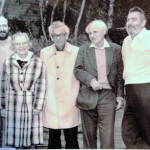Today (March 26, 2013) marks the 100th birthday of Paul Erdös, the eccentric yet beloved mathematician who died in 1996.
Paul Erdös is arguably the most prolific mathematician in history. Working in collaboration with over 500 researchers, he published in fields as diverse as combinatorics, set theory, graph theory, analytic number theory, approximation theory, ergodic theory and probability theory.
Erdös was born in Budapest on March 26, 1913, as the only surviving child of two Jewish mathematicians. His mathematical genius was evident quite early — at the age of four, he would dazzle those around him by calculating, in his head, how many seconds had elapsed in a person’s life, given their age. At age 16, his father introduced him to set theory and the theory of infinite series. In 1934, at age 21, he received a doctorate in mathematics.
Due to concern over rising anti-Semitism in Hungary, he moved in 1934 to Manchester, England, where he had a post as a guest lecturer. In 1938, he was invited to Princeton, where he remained for several years. In 1952, during the McCarthy era, the U.S. government denied Erdös a re-entry visa, for reasons that still remain unclear. It was a period where members of the British Labour Party could not enter the US. Accordingly, Erdös left until the U.S. government changed its mind in 1963.
One of the current bloggers [JB] met Uncle “Pol” as an infant; because in the fifties his father (David Borwein) was on Paul Erdös’ regular visit itinerary in Saint Andrews, Scotland. Erdös called all small children “epsilons” (because the Greek letter “epsilon” is often used by mathematicians to denote a very small quantity). He enjoyed doing magic for them with coins and bills. JB went from being an “epsilon” to having “epsilons” himself during Erdös’ life.
Erdös was staying with the family in 1961 when JB’s mother went into labor in the wee hours. Paul as always woke early, read a note on the table and left. Six months later he wrote asking about the new baby. The answer was sent to the Hungarian Academy of Science, where Erdös had a nominal home. The postcard—all in symbols—must have horrified several Cold War Secret Services. Sent by David Borwein, it read “epsilon_3= female symbol.”
Paul had his own slang: wives were “bosses,” children, as noted above, were “epsilons,” and God was the “Great Fascist.” Erdös was an atheist.
Erdös published 1525 papers, by one accounting, more than any other mathematician in history. Leonhard Euler published somewhat more total pages, but not as many individual papers. Perhaps Erdös’ most outstanding contribution was the application of probabilistic methods to Ramsey theory, a subfield of mathematics that asks questions such as “how many elements of some structure must there be to guarantee that a particular property will hold?” Erdös also made seminal contributions to extremal combinatorics, analytic number theory and combinatorics. He is counted as one of the independent discoverers of an elementary proof of the prime number theorem, namely the result that the number of primes up to and including some integer x is roughly x / log(x).
Erdös certainly had an eccentric style. Eschewing material possessions, marriage, children, religion and other accoutrements of life that many regard as essential, he devoted himself entirely to mathematical research. Possessing little more than a bag and a much loved radio (and a big bag of uppers, downers and every other kind of pill), he travelled from collaborator to collaborator. He did not wear underwear to economize on space.
Paul was known for showing up on a colleague’s door with the words “My brain is open” (also the name of a quite good biography). In later life he had a `regular schedule’; which meant he was with Ron Graham in New Jersey at US tax time and so on. His mother travelled with him for the final ten years of her life and died in Canada.
In many ways, his questions had more impact than his answers, and made him such a central member of the community for so many years. But one of his most important contributions was to the development of probabilistic methods in number theory and discrete mathematics.

Erdos surrounded by mathematicians George and Ester Szekeres (see happy ending problem) with Roger Eggelton (L) and John Selfridge (R). Taken in Newcastle, NSW, Australia, 1983.
One key example, for which Erdös will long be remembered, was his custom of offering prizes for solutions to unsolved problems that he regarded as particularly significant. These awards ranged from a nominal $25 to several thousands dollars. Even $50 problems were very hard. These prizes are now being administered by Ronald Graham. One of better known of these problems, namely the conjecture that the primes contain arbitrarily long arithmetic progressions, was subsequently proved and is now known as the Green-Tao theorem. A related problem, known as the Erdös conjecture on arithmetic progressions, remains outstanding.
Perhaps the best-known tribute to his prolific career is the now-widespread custom of assigning Erdös numbers to contemporary mathematicians. Someone who actually co-authored a paper with Erdös is assigned Erdös number 1. Those who are a co-author with one of these co-authors are assigned Erdös number 2, etc. The present bloggers are both assigned Erdös number 2 (as are JB’s father and brother). For details, see the Erdös Number Project.
Erdös stories also abound—some true, some dubious. A collection will be the subject of a later blog. Despite Erdös’ apparently monomaniacal interest in mathematics, Paul was very well informed on most subjects. Remember the travel radio! He once surprised the Chairman of the Board at University of Western Ontario when, after receiving an honorary degree, he talked knowledgeably about race horses.
Additional information may be had in a Wikipedia article, in a Scientific American article by Calla Cofield, and in a Huffington Post article by Colm Mulcahy.